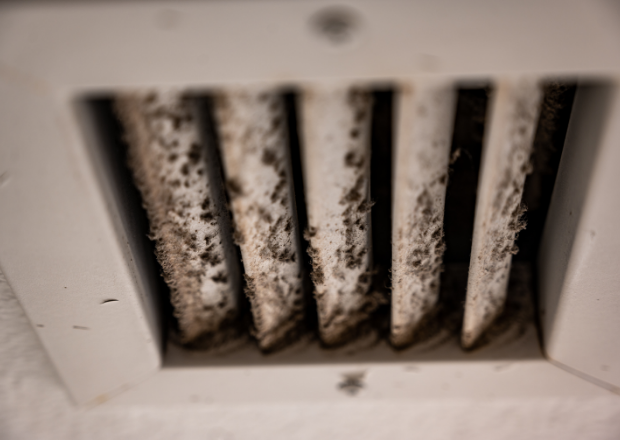Air vents are one of the most visible components of your home’s heating and cooling system. The most basic definition of air vents is any opening that moves air in and out of a space. Depending on the design of your home and HVAC system, vents may appear on the ceiling, floors and along the walls throughout your home. Since vents deliver air into all the rooms of your home, understanding how your HVAC system works and how to clean vents is important.
Understanding Air Vents and Ducts
Consider your furnace and air conditioner as the heart of your heating and cooling system. Air is treated within these appliances then dispersed through ductwork like veins stretching throughout your home. Finally, air is delivered through air vents like arteries into the rooms of your home. While an air duct is fixed, each vent can be adjusted to control air flow into individual rooms. Keeping all of these components clean and maintained is vital to reducing indoor air pollution.
Furnaces, air conditioners and heat pumps should be maintained before the start of each season. Each of these major appliances benefit from cleaning, calibrating and preventive maintenance. Outdoor air contains moisture, dust and debris that can greatly impact the performance and durability within these systems. Cleaning the area around air conditioners is important for performance. Furnaces feature air filters to improve indoor air quality before moving air into ducts and through vents. The best way to improve indoor air quality is scheduling annual maintenance on your furnace and air conditioner.
Air ducts are fixed throughout your home. Metal ducts and flexible ducts are most commonly used to carry treated air to your home’s living areas. Clean air ducts improve the overall comfort within your home. A light amount of household dust is expected to collect in any air duct. Air ducts professionally cleaned may reduce the risks associated with pet dander, mold growth and excess ducts from your home. While there is no definitive study, frequent duct cleaning may improve indoor air pollution for sensitive family members with allergies, asthma and other respiratory concerns.
One definitive rule states duct cleaning should be performed by a professional when excess dust builds up in the system; vermin and other pests have been present in and around ducts; and any time moisture contaminates your duct work. There is a high risk of biological contaminant growth when excess dust and water collect. Anytime visible mold growth appears on vents or ducts, you should contact a heating and cooling professional for proper cleaning. Mold contamination and mold spores pose serious health problems for any family member.
While properly maintained furnaces, air conditioners and ducts require professional heating and cooling professionals, clean air vents are part of regular house cleaning. Removing dust and any other debris from vents will improve comfort, reduce airborne irritants and protect the entire system.
Different Types of Vents
Throughout your home, you may find two types of vents. Once you understand what each type of vent does, you will understand why cleaning vents is important.
Supply Vents
Supply vents deliver air into each room. These are the rectangular vents air enters into rooms. Common sizes include 4×10″, 4×12″, 6×10″ and 6×12″. Controlling how air moves throughout your home is important to calibrating the system. Since most supply vents can be adjusted to increase and decrease the flow of air, professional technicians can improve overall home comfort during maintenance. Adjustments, vent covers and other techniques can be used to improve energy efficiency and save on energy bills. A clean supply vent reduces dust and debris from circulating throughout the room.
Return Vents
Return vents draw air from rooms and send it back to the air conditioning or heating system. As air enters your home through supply vents, existing air moves out of your home through return air vents. This maintains air pressure in your home. When properly installed and calibrated, return vents improve efficiency and save on energy bills.
Cleaning Vents
Cleaning your home should include cleaning both supply vents and return vents. Just like removing dust and debris from surfaces and floors, cleaning vents improves indoor air quality. Air will move freely through clean supply vents into rooms and stay clear when exiting through clean return vents. Cleaning vents helps you notice sudden increases of dust or moisture. Any moisture on vents, especially signs of mold, is a cause for alarm. You should contact our professional services at the first indication of humidity. Excessive moisture may be helped by adding a dehumidifier to your home. Sudden increases of dust on vents may indicate your ducts should be professionally cleaned to address poor ventilation.
When Poston Brothers Heating and Cooling can Help
Since you cannot see the ductwork within your home, watch for warning signs that you need our professional services. If you see excess dust in sunlight near windows, along register vents or other surfaces, then you may need cleaning of the interior ductwork. If your air filter is clogged or excessively dirty, there could be damage to your ductwork. Rising energy usage may indicate clogged systems or air ducts. Musty smells in your home indicate high moisture levels. Any other signs of mold or vermin should prompt a call to Poston as well.
Finally, scheduling regular maintenance with our team of skilled technicians is the best way to keep vents clean, adjusted and ensure healthy indoor air quality. You can ask our technicians the best way to clean air vents in your home. We also calibrate your HVAC system during regular maintenance. This means our team checks to make sure vents are properly adjusted, return vents are clean of obstructions and air flow is optimized throughout your home. From cleaning air vents to installing complete systems, Poston Brothers Heating & Cooling is an expert in every HVAC component.


